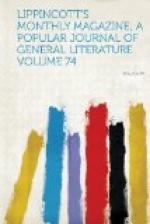Possibly the Post-office Department would be less of a valetudinarian, financially, had it confined itself to its legitimate occupation, the speeding of intercourse and wafting of sighs, and not yielded to the heavy temptation of disseminating shoes, pistols and garden-seeds over three millions of square miles. Newspapers are enough to test its powers as a freight-agent. Where these and their literary kindred of books, magazines, etc. used to be estimated by the dozen and the ounce, the ton is becoming too small a unit.
West of the Blue Ridge, or the front line of the Alleghany, so called in most of its length, there was not a newspaper published in 1776. Ten years later, scarcely more than one—the Pittsburg Gazette—existed west of the mountains. The few in the seaboard towns kept alive the name, and little more. In 1850, ’60 and ’70 the periodicals of the Union numbered, respectively, 2526, 4051 and 5871, with an average circulation, at the three periods, of twenty-one hundred, thirty-four hundred and thirty-six hundred copies each. The circulation thus outgrew the numbers in the proportion of nearly two to one. And both are largely in excess of the increase of the population, that being in the twenty years but 65 percent. The number of daily papers (254 in 1850 and 574 in 1870) must now be equal to the entire number of periodicals in France outside of Paris (796 in 1875), with an average issue less than half that of ours. The proportion of readers to the population, certainly in this class of literature, thus appears to be rapidly growing: and the change is most striking if we take, for example, that group of periodicals which are most purely literary and most remote from the mere chronicle. The returns for the three periods place the monthlies at, respectively, 100, 280 and 622—an advance of sixfold.
The magazine leads us to the door of the library; and here the exhibit is still more marked, significant and gratifying. The census figures are, for many reasons, extremely confused, but in the general result they cannot be outrageously wrong, and they can mislead us only in degree as to the immense multiplication of books in both public and private libraries. The returns are manifestly far below the truth. To give them here without the explanations accompanying them in the census volumes would mislead; and those explanations, or a fair synopsis of them, would occupy too much space, and would, after all, leave the problem unsolved. That the supply of books has fully kept pace with every other means of culture is patent enough. The Congressional Library has risen in half the century from the shelves of a closet to nearly four hundred thousand volumes—an accumulation not surpassed in ’76 by more than two libraries in Europe. It now demands a separate edifice of its own, fit to stand by the side of the fine structures which have within a generation recreated the architectural aspect of the Federal metropolis with the most stately




